Return to the main conference page.
Return to the reports page.
Report on “Religions and Local Society in the Historical, Comparative, and Theoretical Perspectives: An International Conference in Honour of Professor Timothy Brook”
Xiangjun Feng (University of British Columbia)
November 9, 2022
“Religions and Local Society in the Historical, Comparative, and Theoretical Perspectives: An International Conference in Honour of Professor Timothy Brook” took place between August 12 and 14, 2022, at University of British Columbia (UBC) and online concurrently. This conference was hosted by the Glorisun Global Network for Buddhist Studies at UBC, with administrative support from the From the Ground Up: Buddhism and East Asian Religions (FROGBEAR) Project at UBC & the International Center for Studies of Chinese Civilization and Department of Religious Studies at Fudan University. It was one of the two major events this summer in celebration of Timothy Brook’s retirement from teaching positions, after serving the academia for almost four decades as a leading historian of China. It paid special tribute to one of Brook’s earlier monographs, Praying for Power: Buddhism and the Formation of Gentry Society in Late-Ming China (Harvard University Press, 1993), a landmark contribution in the studies of religions and Chinese societies from sociological and regional perspectives. Forty-two presentations, organized in eleven panels, together attested to the long-lasting influence of Brook’s pioneering work as well as its high relevance in today’s world. Building upon the legacy in China and Buddhism, however, these presentations demonstrated stunning religious, regional, historical, and methodological diversities, ranging from Abrahamic religions to popular beliefs, from Europe to Southeast Asia, from the ancient world to the contemporary, and from anthropological ethnography to digital humanities. This manifested an admirable mode of scholarly production and reproduction: an exemplary study focused on a particular theme and locality inspired the rise of multidimensional explorations across various boundaries.
Day 1
The conference started with a cosy gathering at the St. John’s College, University of British Columbia, where Brook served as the principal for many years. Timothy Cheek and Diana Lary, both Brook’s UBC colleagues and lifelong friends, shared with the onsite participants some of the unforgettable memories of working with Brook in the past decades, which were also synchronously streamed for the online participants and audiences dialled in from across the world.
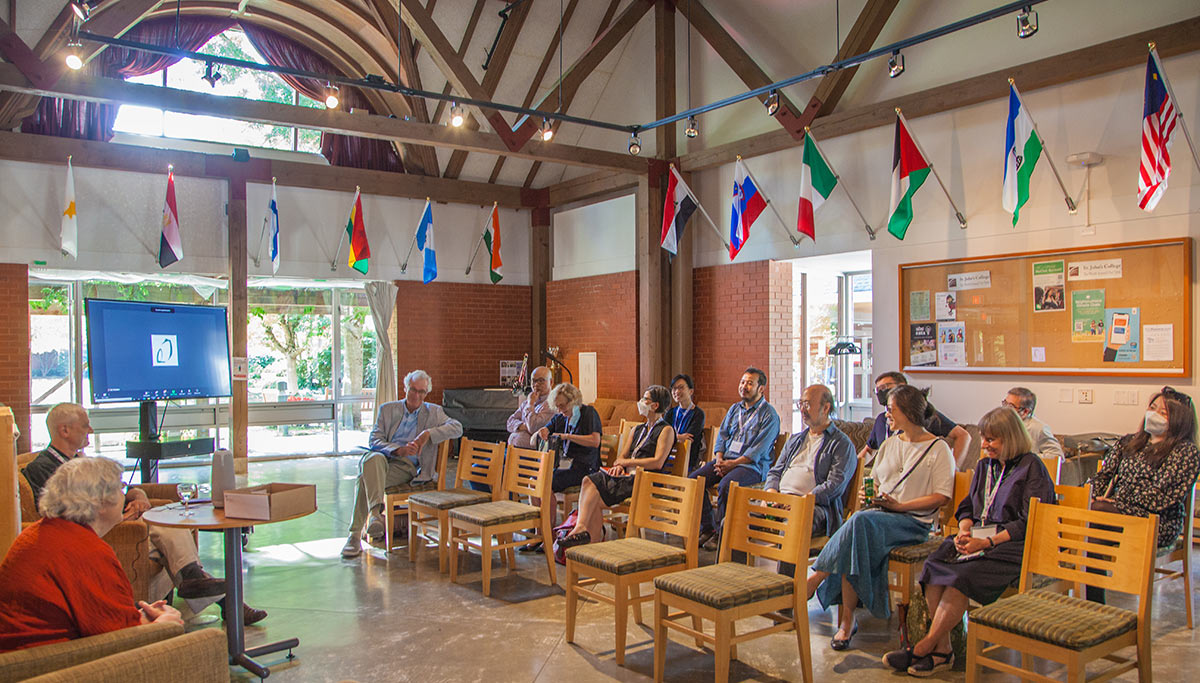
Timothy Cheek and Diana Lary (on left) speaking to Timothy Brook and attendees at St. John’s College, University of British Columbia.
After Jinhua Chen (UBC) and Tiangang Li (Fudan University) offered their welcoming remarks, Brook delivered the first of the two keynote speeches of the conference: “What is Local Buddhism, and Where can we Find it?” He recalled his first encounter with the Qing-dynasty Buddhist pilgrimage handbook, the Canxue zhijin 參學知津 (Knowing the fords on the way to knowledge), back in graduate school, and reflected upon how this source had recently inspired him to rethink the difference between Buddhism rooted in the local societies and what he proposed to call “tourist Buddhism.” This talk was not only a wonderful example showing how a historian diligently approached the same primary source with changing methodological-theoretical energies throughout the whole career, but also helped complicate the shift of focus from China per se to China in the global world, a trend in both Brook’s more recent works as well as the broader academia, by drawing out a more nuanced three-level framework: the local, the trans-local (the national), and the transnational (the global).
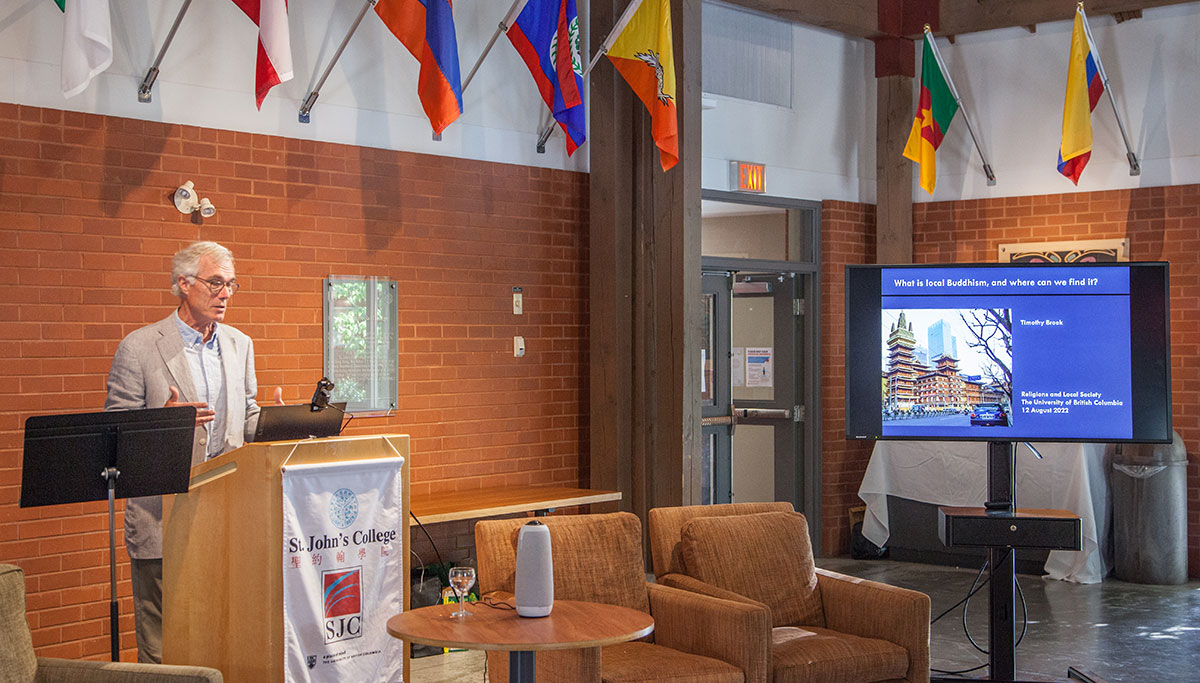
Timothy Brook, keynote presentation.
Brook continued to serve as the discussant of the first panel, “Religious Battling and Blending (1): Interactions between the Indigenous & Imported,” chaired by Alison Bailey (UBC). The three panelists each introduced one case study from a particular locality to shed new light on this theme. Lianbin Dai’s (University of Victoria) presentation, “Forging the Chineseness of Kaifeng Jewry: The Ming State and Neo-Confucian Elite Behind the 1489/1512 Inscriptions,” contextualized the Kaifeng Jews’ acculturation in the political agendas and intellectual climate in the fifteenth- and sixteenth-century China, revealing that the Judaists, together with the Muslims and other religious practitioners, were not administered by the Ming state as religious groups but as “ethnic groups” who needed to adjust to a secular and Confucianism-dominated society. Moving from Henan to Hebei and Shanxi, Qingping Deng (China University of Political Science and Law/UBC) investigated Willem A. Grootaers’ (C.I.C.M., 1911–1999) pioneering work in this area in the 1930s and 1940s. The article “A Geographic Approach to Popular Religions: Willem A. Grootaers’ Fieldwork Research in Rural Northern China” 民間宗教的地理學研究:賀登崧神父的中國北方鄉村調查 noted that current scholarship had mostly focused on Grootaers’ linguistic and folkloristic research but had not paid due attention to his “geographic approach to popular religions” which, Deng argued, demonstrated a unique balance between “the method of fieldwork” and “the ‘book’ method.” Thierry Meynard’s (Sun Yat-sen University) paper “Christian – Buddhist Conflicts in Late Ming Dynasty: New Light from the Chengdu conflict of 1643” examined a little-known religious incident in Southwestern China. Reading a lengthy report written in Portuguese in 1644, which was probably the source for some later brief and contradictory accounts, Meynard confirmed that the conflict was indeed launched by the Buddhist (not Daoist) monks in Chengdu who were also in contact with the Buddhist circles in the Jiangnan area.
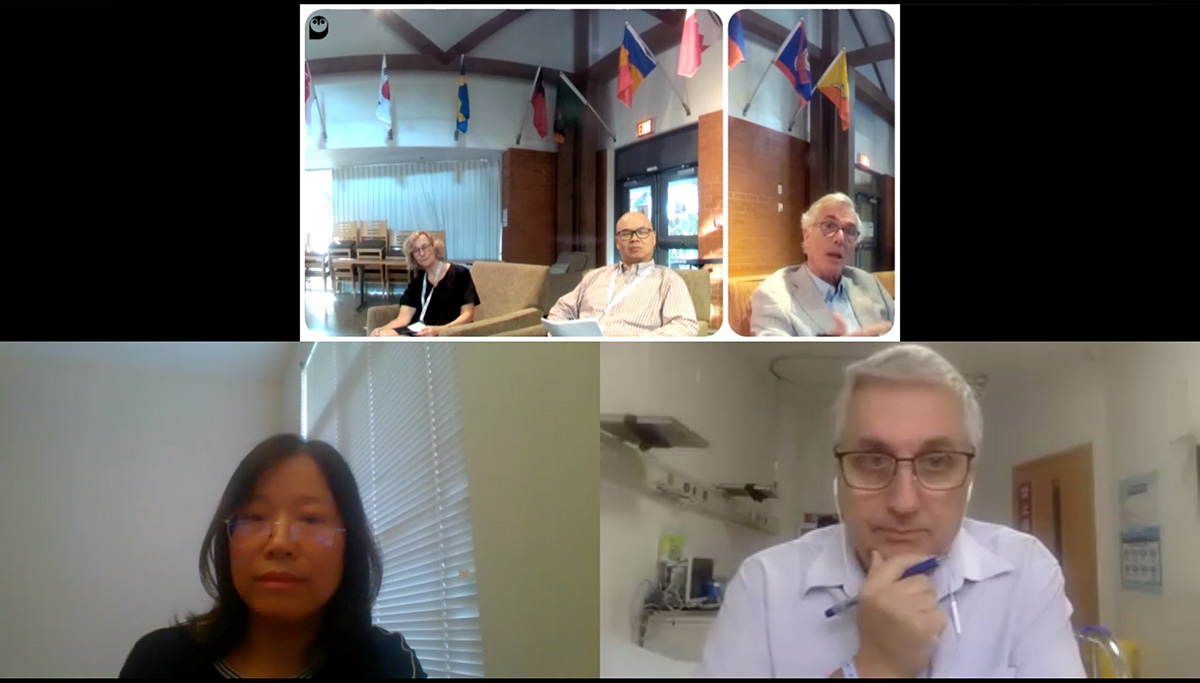
Top row : Alison Bailey, Dai Lianbin, and Timothy Brook. Bottom row : Deng Qingping and Thierry Meynard.
The second panel, “Media of/as Message: Shifting of Medias for Transmission of Buddhism,” was chaired by Keping Wu (Duke Kunshan University) and co-discussed by Sheng Kai (Tsinghua University) and Eugene Wang (Harvard University). Guodong Feng’s (Zhejiang University) article “Revisiting the Records of Song-dynasty Buddhist Canons” 宋代佛教藏經記再探 explored the changing modes of Buddhist texts production, preservation, and consumption in the Song dynasty by focusing on an unique genre, cangjingji 藏經記 (literally, records of Buddhist canons). Echoing this approach, Qi Sun (Shandong University) used another kind of writing, zaoxiang tiji 造像題記 (statue inscriptions), to reconstruct the history of a Tang dynasty Buddhist sacred site in the paper “A Ruined Grotto Revisited: Study of Xuanwushan Grottoes in Hebei” 一座消失的石窟:河北宣務山石窟研究. Xiao Yang’s (Chinese Academy of Social Science) presentation “Move to the Land of Abundance: Buddhist Sites in Northern Sichuan in the Early Seventh Century” was also about the Tang dynasty Buddhist statues and grottoes, yet with a different geographical focus. Through the lens of a few sites constructed in Northern Sichuan at the beginning of the dynasty, Yang saw the social and religious changes brought to Sichuan by officials and monks from the north during the Sui-Tang transition. Moving from the medieval period to the more recent centuries, the rest two presentations of this panel focused on Beijing in the late Qing–Republican era and Wenzhou in contemporary China, respectively. Xuesong Zhang (Renmin University of China) in “Temple Households (Miaohu) and Shop Guarantors (Pubao) of Buddhist and Taoist Temples in Beijing during the Late Qing Dynasty and Republican Period” 晚清民國時期北京社會中佛寺道觀的廟戶與鋪保 shed new light on the relationship between Buddhist and Taoist temples and local society through the investigation of the changing status of two government-regulated social systems, whereas Jing Le (Shanxi Normal University) in “The Metaphor of ‘Gold and Silver’: An Interactive Medium of Faith and Credit——Take the ‘Sutra Worship’ Ceremony in Wenzhou as an Example” 「金銀」的隱喻:信仰與信用的互動媒介 ——以溫州「拜經」儀式為例 revealed how paper “currency” in popular religious practices today could play significant role in social life just as real money.

Top row : Wu Keping, Sheng Kai, and Eugene Wang. Middle row : Feng Guodong, Sun Qi, and Yang Xiao. Bottom row : Zhang Xuesong and Le Jing.
Day 2
The third panel “Religious Battling and Blending (2): Negotiation between Buddhist & Non-Buddhist Imported” marked the beginning of the second day of the conference. This panel was chaired by Xu Ma (Lafayette College) with Jiade Shao (Nanjing University) serving as the discussant. Rostislav Berezkin (Fudan University) in the presentation “The Mystery of the Miaoshan Legend Origins in the Perspective of World Folklore Motifs” introduced a new global perspective to look at the well-studied Chinese Miaoshan legend. From this perspective, Berezkin proposed the hypothesis that the Miaoshan story bore the influences from several popular folklore motifs across different cultures. Wei Xu’s (Fudan University) paper “The Ming Neo-Confucian Scholar-cum-General Wan Luyuan’s (1498–1556) Buddhist Travels and Daoist Cultivation” 明儒都督萬鹿園的佛教行腳與道教修煉 studied the biography of Wan Biao (style name Luyuan) and revealed how this individual successfully integrated neo-Confucian learnings, military actions, and religious practices in his life. Cheng-Tsung Kan (Fo-kuang University) in the presentation “Local Gentry and the Buddhification of the Zhaijiao Religion in Puzi during Taiwan’s Colonial Period” 殖民時期朴子官紳與齋教佛教化 examined how the Zhaijiao religion, a variation of the Luojiao 羅教 popular religions, was reformed by the Japanese Pure Land Buddhism with the help of the local gentry class in the first half of the twentieth century. Coming to the contemporary world, Keping Wu used rich examples from her ethnographic fieldwork between 2014 and 2019 to reveal the complicated process which she characterized in the title “‘Buddhification’ and ‘Daoification’ of Local Religions in Contemporary Suzhou.” Wu argued that the “pantheon” of local religions in Suzhou was shaped by the two major institutional religions under the state’s auspice in the overwhelming process of urbanization, yet at the same time they exerted influence on the Buddhist and Daoist landscapes.
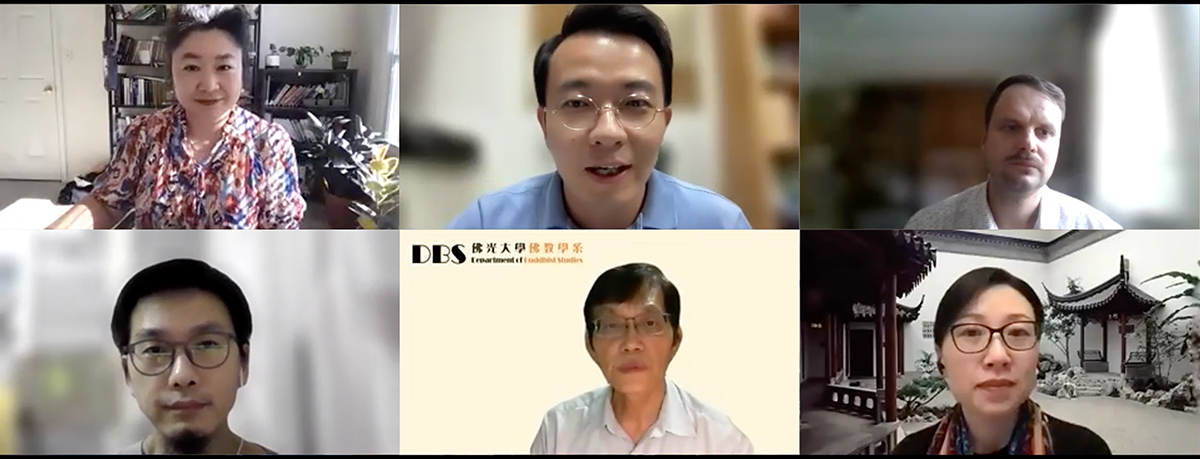
Top row : Ma Xu, Shao Jiade, and Rostislav Berezkin. Bottom row : Xu Wei, Kan Cheng-Tsung, and Wu Keping.
The fourth panel, “Temples as Fields of Power,” was chaired by Cuilan Liu (University of Pittsburgh) and discussed by Yang Lu (Peking University). Bing Wei’s (Wuhan University) paper “Temples and Political Culture in the late Northern Dynasties: ‘State’ Temples, Administrative Divisions, and Battle Fields” 北朝晚期的寺院與政治文化——“國”寺、政區与戰場 investigated the emergence of “state” temples in medieval China that also served administrative functions. While existing scholarship saw the Sui dynasty as the beginning of this new religious/political culture, Wei traced its origin to the earlier Northern dynasties. Anna Sokolova’s (Ghent University) paper, “The Establishment of the Dharmaguptakavinaya Tradition at Kuaiji 會稽 in the Early Eighth Century China,” was also focused on a new Buddhist phenomenon in the Tang dynasty, namely, the rise of the Sifen lü 四分律 (Dharmaguptakavinaya) tradition. It argued that the Kuaiji monastic-secular community played a key role in the wholesale dissemination of the Dharamaguptakavinaya tradition in Southern China during this period. Mónika Kiss’s (Eötvös Loránd University [ELTE]) presentation shifted from medieval China to contemporary Japan. In “Buddhist Responses to the Problems of Society: The Case of the Nichirenshū,” Kiss exemplified how Buddhist groups today made efforts to adjust to the fast-changing society and deal with various social tensions. This was followed by Mariia Lepneva’s (Institute of Oriental Studies of the Russian Academy of Sciences) paper “Refreshed Revival: Success of Baohua Mountain in the Eighteenth Century China.” Her paper pointed out that existing studies on the Baohua Mountain as a model monastery had mostly focused on the late nineteenth and early twentieth centuries. Different from this, Lepneva went two centuries earlier to examine how this monastery earned its fame as a seat of the revived Vinaya school in the first place. Last but not least, Laura Boyer’s (L’École des hautes études en sciences sociales) presentation “Regulating Fangsheng 放生 Activities in Jiangnan, between Local Particularities and Historical Divergences” compared the rules about the fangsheng (releasing animals) ritual written in three different Jiangnan cities in the late imperial period, and by doing this shed new light on the zoological and ecological dimensions of Chinese religion.
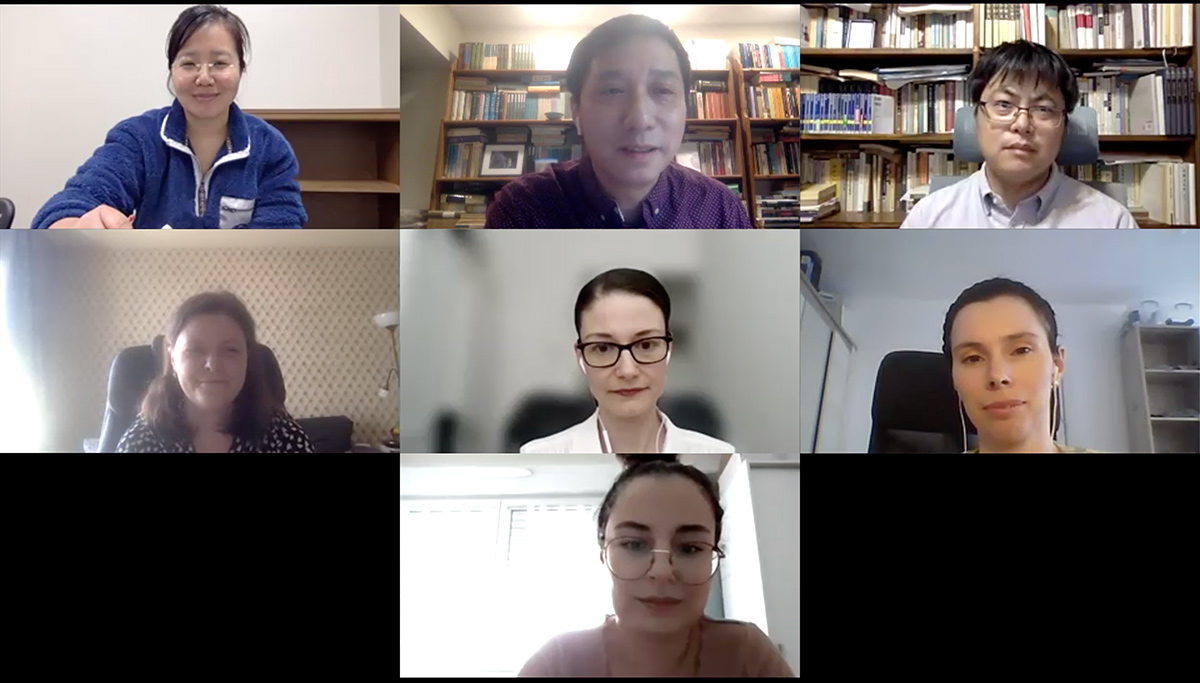
Top row : Liu Cuilan, Lu Yang, and Wei Bin. Mid row : Anna Sokolova, Mónika Kiss, and Mariia Lepneva. Bottom row : Laura Boyer.
The fifth panel, “Printing for Power,” responded to both the ongoing academic trend of print culture studies and Brook’s 1993 book title Praying for Power. Chaired by Mónika Kiss and discussed by Barend ter Haar (Hamburg University), three panelists each provided a different angle to look at how the new printing boom in the late imperial period influenced religious practices. Noga Ganany’s (University of Cambridge) paper “Popular Reverence and Commercial Publishing in Late Ming Hagiographic Literature” focused on what she called “hagiographic narratives,” a genre born in the late Ming print culture. Through these religious texts that were produced explicitly for popular consumption, Ganany explored the complicated relationship between religious practices and the publishers’ commercial considerations. Dewei Zhang pointed out that although Buddhist texts proliferated dramatically, partially thanks to the print boom, in the Ming-Qing period, we still knew very little about the reception of Buddhist canons. Zhang discussed some dimensions of this question in “Embedded to Keep Alive: Receiving the Buddhist Canon in the Local Society,” arguing that “being used” (including but not limited to “being read”) was how a canon exerted influence on a local society. Similar to Zhang, Xu Ma’s article “Printing for Power: The Textualization of Popular Religions in the Ming Leishu” also paid due attention to the readers/users’ responses. She argued that the popularized religious contents in the Ming-dynasty leishu 類書 (compendia and encyclopedias) allowed the readers to evoke a “personalized pilgrimage or self-directed rituals,” which afforded us “a glance at the unprecedented power partaken of by the rising reading public in producing and reproducing a nuanced boisterous religious life in the Ming.”
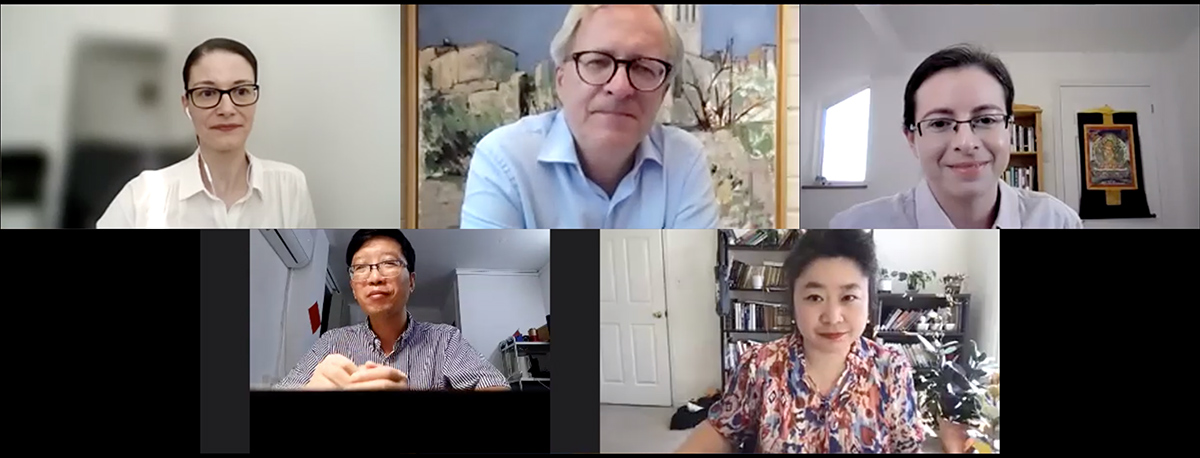
Top row : Mónika Kiss, Barend ter Haar, and Noga Ganany. Bottom row : Zhang Dewei and Ma Xu.
“Identity Struggles” was the theme of the sixth panel, which was chaired by Tiangang Li and discussed by Qingping Deng. The first case of “struggle” was contributed by Jianming He (Renmin University of China). In “The Paradox of the Religious Conventions and State Recognitions regarding the Daoist Lineages in Modern China” 現代中國宗派傳承與認定的弔詭, He pointed out the tensions that the Zhengyi 正一派 and Quanzhen 全真派 Daoist practitioners experienced when the state executed a categorization system which was different from their own conventions. Cuilan Liu’s paper “From Murderers to ‘Monks’: The Dual Life of Criminals in Rural China” started with the case of Xu Xinlian, a murderer who disguised himself as a monk to avoid legal punishment in contemporary China. From there, Liu went further to exam a longer history of both the phenomenon and the fantasy about the religious institutions’ function as sanctuaries for criminals. Kuei-Min Lee’s (Cheng Kung University) presentation, like Jianming He’s, was about the problems that occurred in the transmission of religious lineages, yet with a different focus on the Vietnamese Buddhism. In “The Construction of the Vietnamese Monks’ Lineage and the Shaping of the Vietnamese Chan School” 越南僧人燈錄體系的建構與禪派的形塑, Lee untangled the complicated history of Buddhist transmissions in Vietnam, and pointed out that these complexities were part and parcel of the localization of Buddhism in Vietnam in different historical contexts.
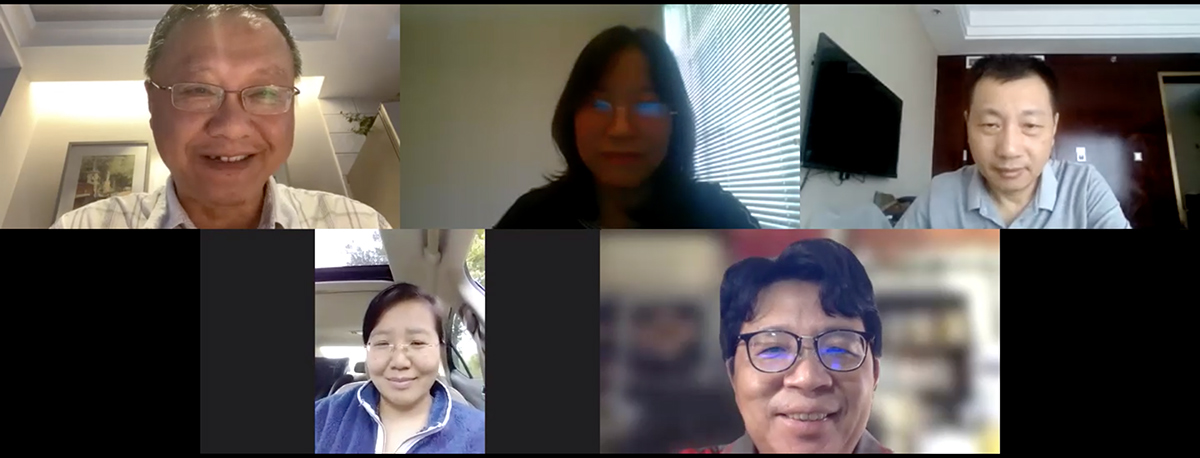
Top row : Li Tiangang, Deng Qingping, and He Jianming. Bottow row : Liu Cuilan and Lee Kuei-Min.
The seventh panel “Network Construction” was chaired by Jianming He and discussed by Xiao Rao (University of North Carolina in Greensboro). Jian Cao’s (Sun Yat-sen University) article “The Problem of Tribulation in the Bible from Multiple Perspectives: A Comparison of Communal Experiences in the Ancient Near East” 多維視野中聖經世界的苦難問題探析:基於古代近東社群經驗的比較 put together discourses from Sumer, Babylon, Egypt, Assyria, Israel and Greece of the ancient Near East and examined how these different civilizations approached the origins and meanings of suffering in life. Marcus Bingenheimer’s (Temple University) presentation “Distinguishing two Stages in the Late Ming Buddhist Revival: A Social Network Approach” applied digital humanities techniques to reconstruct the Buddhist social networks in the late Ming. The visualization of these networks made it clear—Bingenheimer echoed Brook’s point in Praying for Power—that the revival of monastic Buddhism in the late Ming was an obvious phenomenon. Moreover, this method helped differentiate the roles played by two groups, one in the Wanli 萬曆 period and a later group led by Miyun Yuanwu 密雲圓悟, a difference that previous scholarship failed to notice. Kai-ting Chien’s (Taiwan University) article was entitled “A Brief Discussion of the Sōtō School Monk Zenmyo Gettan’s ‘Transnational Communication’ in the Edo Period” 江戶曹洞宗僧全苗月湛「異國贈答」一事論略. Tracing a small clue in primary sources, Chien reconstructed an unknown story about the Japanese monk Zenmyo Gettan and his communications with Chinese monks. This case study allowed Chien to consider East Asian Buddhism from a larger transnational perspective.
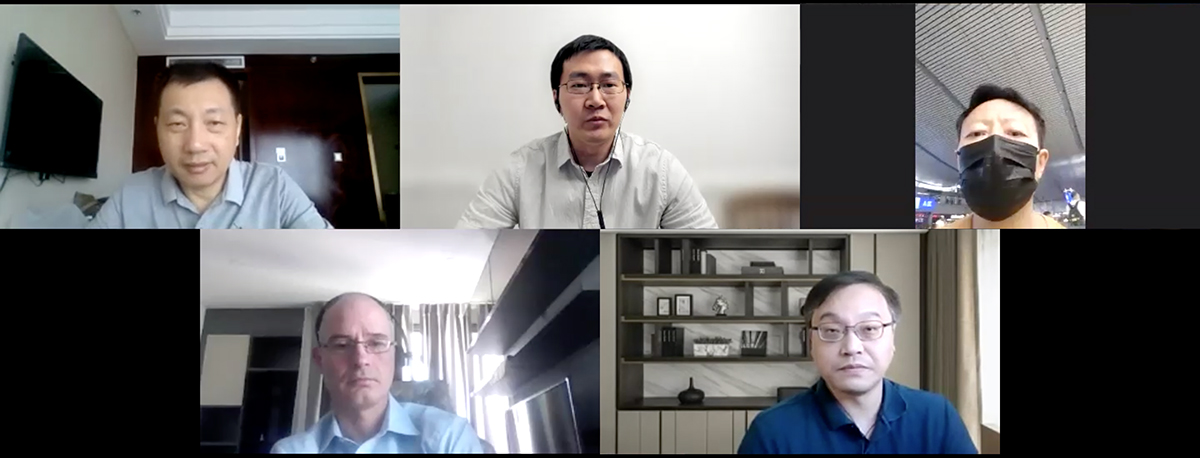
Top row : He Jianming, Rao Xiao, and Cao Jian. Bottow row : Marcus Bingenheimer and Chien Kai-ting.
“The Local vs the Cosmopolitan” was the theme of the eighth panel, in which Lianbin Dai served as the chair, with Benoit Vermander (Fudan University) and Xu Ma as co-discussants. Tiangang Li’s presentation “Max Weber and Sinology: A Philological Reading of The Religion of China” 韋伯與漢學:《儒教與道教》的文獻學解讀 studied how Weber’s narrative of Chinese religions was shaped by European Sinologists, such as Jan Jakob Maria de Groot, James Legge, and Émmanuel-Édouard Chavannes. Eugene Wang traced the emergence and endurance of what he called the “electricity-ether-globalism meme” from the late nineteenth century to the contemporary, in both East Asia and the broader global world. This meme allowed Wang to reread modern Chinese photography, intellectual discourses, and even the 2012 Shanghai Biennale in a new light. Xiaojun Yang’s (Shaanxi Museum of History) article, “On the Relationship between the Tamamushi Shrine in the Hōryū-ji Temple and the Śarīra Veneration during the Renshou Reign of the Sui Dynasty” 法隆寺玉蟲廚子與隋仁壽舍利崇拜的關係, examined the Tamamushi Shrine (玉虫厨子, Tamamushi no zushi) against the backdrop of the East Asian political, religious, and cultural communications in the early seventh century. It revealed that the Tamamushi Shrine was in many ways influenced by the Renshou Śarīra pagodas of the Sui Dynasty 隋仁壽舍利塔. The last article of the panel came from Xiangjun Feng (UBC). “The ‘Lost Scroll’ and the Changing ‘Local’: ‘Taigu School’ and Its Secret Scriptures in China’s Twentieth Century” was focused on the Taigu School 太谷學派, an esoteric and syncretic lineage sometimes known as “the last neo-Confucian school of premodern China.” Tracing how the secret texts of this school were published and made available to the reading public in the twentieth century, this article proposed to rethink the changing meanings of the “local” in China’s modern transition. This panel concluded the second day of the conference.
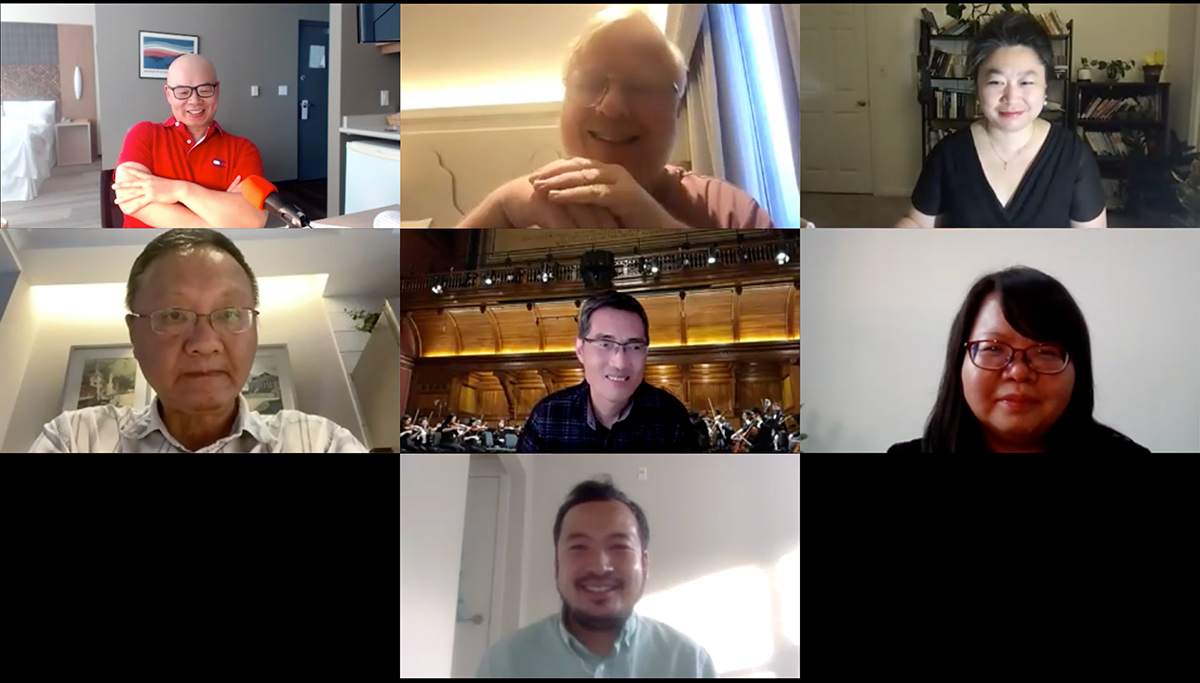
Top row: Dai Lianbin, Benoit Vermander, and Ma Xu. Mid row: Li Tiangang, Eugene Wang, and Yang Xiaojun. Bottom row: Feng Xiangjun.
Day 3
The third day of the conference began with the ninth panel, “The Central vs the Marginal,” chaired by Anna Sokolova and co-discussed by Rostislav Berezkin and Dewei Zhang. The first panelist Ekaterina Skrypnik’s (Russian Academy of Sciences) article was entitled “Buddhist Text Prefaces Attributed to Wu Zetian (624–705) and Some Features of Female Emperor Image Construction in Medieval Chinese Society.” Reading a group of Buddhist sūtras’ prefaces that were attributed to Wu Zhao 武曌, the only women in Chinese history who had obtained the male title of Emperor, Skrypnik revealed how Wu Zhao appropriated the religious power and transformed it into political legitimacy. Shoufu Yin (UBC) then moved from the female emperor to the fictional “Jade Emperor” in the Chinese xiaoshuo 小說 tradition. In “How Should the Dragon King Memorialize the Jade Emperor?: Margins of Political Thought in Late Ming China,” Yin proposed that the formulaic bureaucratic documents embedded in the xiaoshuo novels (which were often skipped by readers) could in fact lead us to “a whole ocean of political theories and imaginations.” Kirill Solonin (Renmin University of China) with “Tangut Platform Sūtra and Chan Biographical Literature” brought the audience back to the real political world. Contextualizing Tangut Buddhist texts in Northern China between the eleventh and thirteenth centuries, Solonin argued that these texts not only helped the studies of the Tangut Buddhism, but also afforded a better understanding of the Sinitic Buddhism in the adjacent areas. Johanna Lidén’s (Stockholm University/Hamburg University) presentation provided an opportunity to listen to a rarely heard “marginal” voice in premodern China. In “Writings on Pedagogy by a Village Schoolteacher from the 19th Century Sichuan,” Lidén focused on Liu Hengdian 劉恆典 (1809–1884), a poor school teacher, and argued that in the nineteenth century Confucian self-cultivation was faithfully practiced by those on the very margins of the society. Coming to the modern period, Jiade Shao’s paper “Religion between the State Power and the Local Power: The Case of the Nationalistic Government’s Reformation of the Nanjing Buddhism” 中央與地方權力之間的宗教:以國民政府對南京佛教的改革為例 tried to avert a dualistic framework, and instead, practiced a more nuanced exploration of the relationship between the state and the local through the lens of temples and their properties which became a field for various power negotiations in the Republican-era Nanjing.
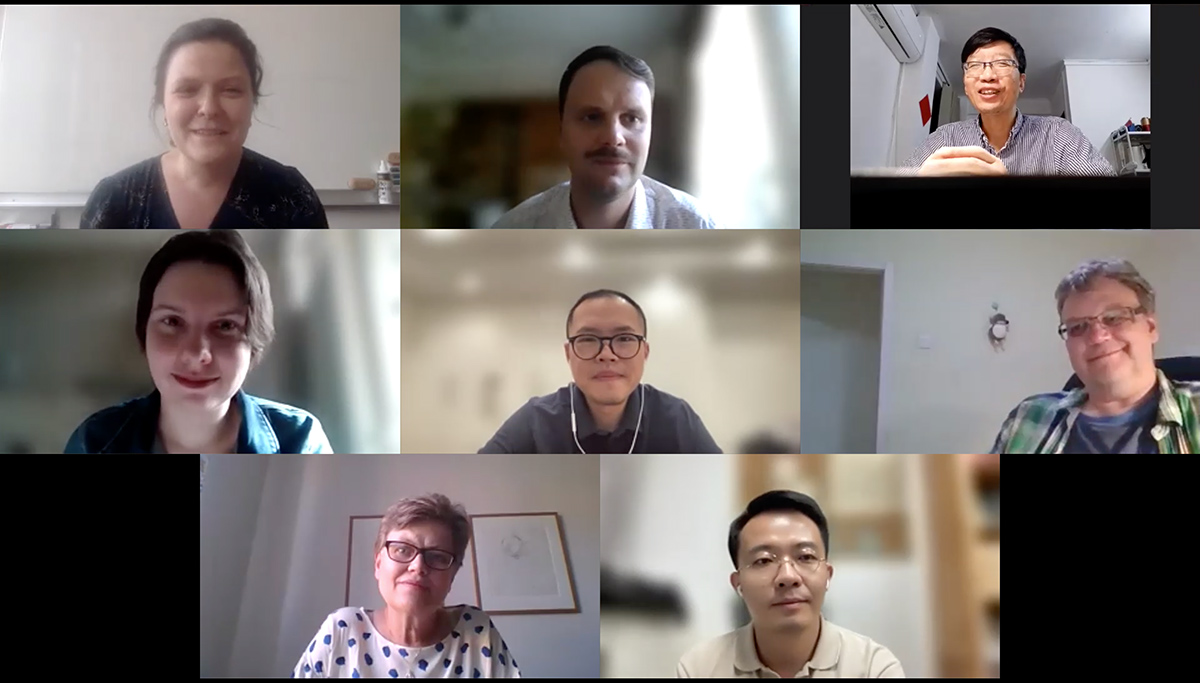
Top row : Anna Sokolova, Rostislav Berezkin, and Zhang Dewei. Mid row : Ekaterina Skrypnik, Yin Shoufu, and Kirill Solonin. Bottomw row : Johanna Lidén and Shao Jiade.
The second keynote speech was delivered by Barend ter Haar before the tenth panel. Two decades ago, ter Haar was one of the many scholars who wrote enthusiastic book reviews for Brook’s Praying for Power. On this special occasion, he again responded to Brook’s work on the Ming dynasty by considering the place of Buddhism in local society in the earlier Song-Jin-Yuan period. The talk was entitled “Buddhism in Local Society: The 1313–1314 Restoration of the Travelling Palace of the Eastern Marchmount in Changxing.” ter Haar closely examined the text “Inscription for the Restoration of the Travelling Palace of the Eastern Marchmount in Changxing Prefecture,” a byproduct of this restoration project, and discovered close collaborations between monastic institutions and agents of the local society, including local officials, local militia, and local guilds and traders. These collaborations, ter Haar argued, urged us to reconsider the relationship between what might be labelled “Buddhist” or “Daoist” agents and the society as a whole. After all, ter Haar wittily reminded us, the concept of “Buddhism” was a late eighteenth century invention, and back in the fourteen century it was the “White Cloud Tradition” that was interacting with the local society.

Barend ter Haar, keynote presentation.
Following ter Haar’s speech was the tenth panel “‘Conspiracies’ between the Elite & Grassroots,” chaired by Kirill Solonin and discussed by Bing Wei. Yuh-Neu Chen’s (Cheng Kung University) presentation was entitled “The Family Origin, Religious Lineage, and Achievement of Female Chan Masters in the Late Ming and Early Qing” 晚明清初女禪師的出身、法脈及其成就, in which Chen not only provided rich sources about these female monastics, but also discussed the social factors that distinguished them from the numerous female religious practitioners of this period. Sheng Kai’s paper “Shared Residence of Chan and Vinaya Monks and Independent Residences of ‘Separate Cloisters’ in the Early Chan Buddhism” 初期禪宗的禅律共住與“别院”别住 differentiated two modes of residence in the early Chan Buddhism: chan monks sharing the vinaya monk’s monastery, and chan monks occupying a semi-independent space within a vinaya monastery. Sheng Kai argued that the tensions occurred in the shared space were an important factor leading to the final independence of the southern Chan tradition. Ziyong You (Capital Normal University/UBC)’s presentation “The Shanquan Monastery and Local Society in Yixing from the Tenth to the Thirteenth Centuries” 10–13世紀的宜興善權寺與地方社會 treated the Shanquan Monastery 善權寺 as a field of power negotiations. In particular, You argued that the monastery’s history during these centuries epitomized a broader trend from the mid-Tang to the Song, namely, Buddhists monasteries became more and more closely controlled by state power.
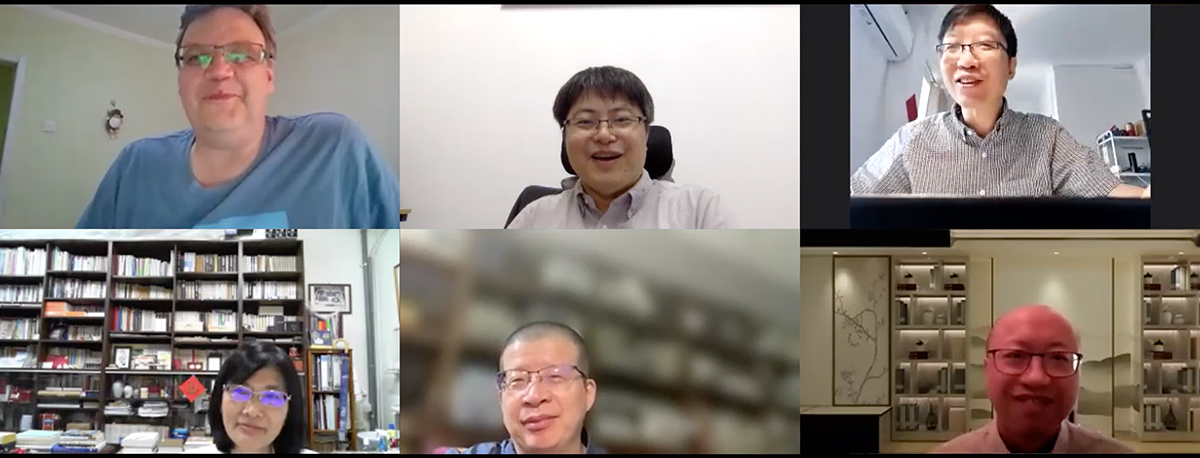
Top row : Kirill Solonin, Wei Bin, and Zhang Dewei. Bottom row : Chen Yuh-Neu, Sheng Kai, and You Ziyong.
The last panel of the conference was entitled “Literary Links: Buddhist Monks and Literature,” with Julia Orell (UBC) and Bruce Rusk (UBC) serving as the chair and discussant respectively. Xiao Rao’s article, “Contesting Frivolity: Amorous Poetry, Courtesans, and Buddhist Monks in Song Dynasty Storytelling,” situated the issue of frivolity, which was often seen as a problematic trend in Buddhism since the Song, in two special contexts of the period: the burgeoning culture of courtesanship and the rising of popular storytelling. Focusing on the amorous poems that were said to be produced with Buddhist monks’ involvements, Rao observed two different modes of understanding these poems and their frivolity, one in stories circulated among the elites, and the other one in vernacular storytellers’ sourcebooks. Qiyuan Wang’s (Fudan University) article, “A Study of the Dharma Names of Lay Buddhists during Late Ming Dynasty: With a Focus on the Lay Followers of Zibo Zhenke” used evidential research to reveal the real identities of some of the lay followers of Zibo Zhenke 紫柏真可, which were otherwise cloaked by their dharma names. It turned out, as Wang suggested, that these followers included the celebrities such as Feng Mengzhen 馮夢禎 (1548–1606) and Tang Xianzu 湯顯祖 (1550–1616).
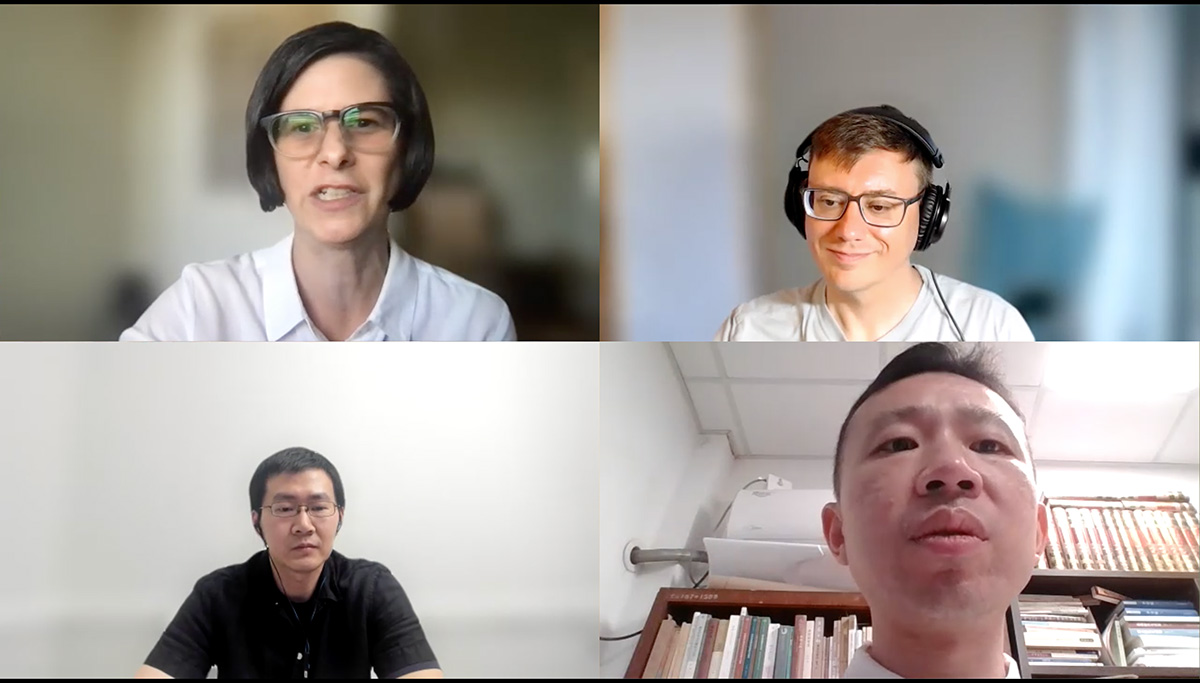
Top row : Julia Orell and Bruce Rusk. Bottom row : Rao Xiao and Wang Qiyuan.
A final discussion marked the successful conclusion of the conference. Tiangang Li and Dewei Zhang again delivered their congratulatory remarks, and Jinhua Chen further discussed some preliminary plans of transforming the conference papers into a festschrift in two volumes. Finally, Timothy Brook expressed his gratitude toward all the organizers, participants, and audience, who, in three days, offered their enthusiasm, wisdom and appreciations from all over the world. Likewise, many sincerely thanked Brook not only for his lifelong academic contributions, but also for this three-day intellectual feast which became possible thanks to his charisma connecting people from afar. Just as Timothy Cheek aptly declared in Chinese at the beginning of the conference: “Professor Brook’s friends are everywhere under the heaven!” 卜正民教授的朋友遍天下!
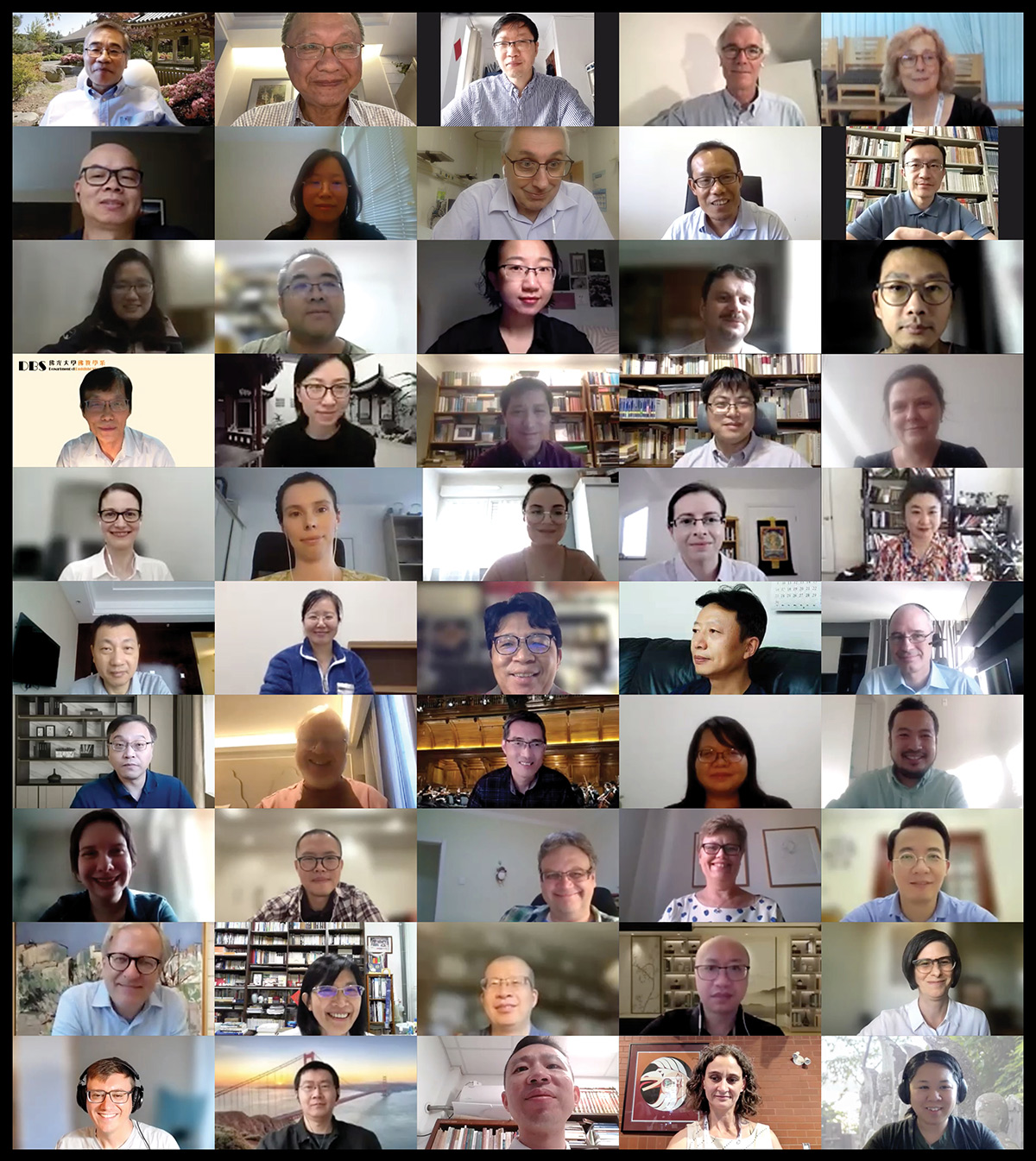
Conference group photo.
